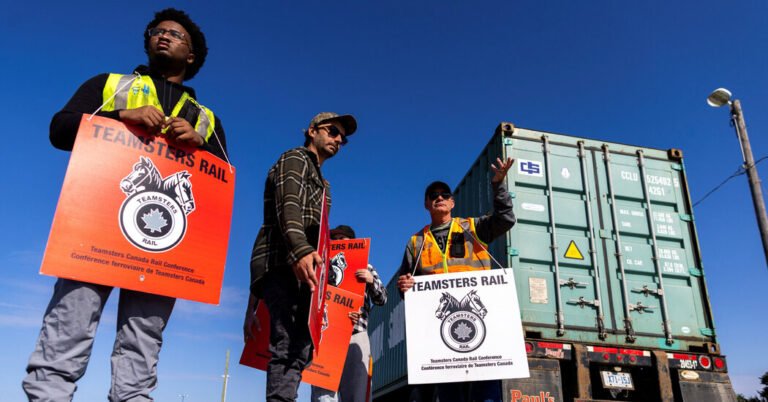
Late Thursday, the Canadian government ordered arbitration between the railroads and the rail workers’ union, a move that will end the shutdown. Read the latest coverage here.
Canada’s two main railroads shut down for several hours on Thursday after contract talks with a labor union failed to reach a deal, forcing businesses in North America to grapple with another big supply chain challenge after several years of disruptions.
The sprawling networks of Canadian National and Canadian Pacific Kansas City are crucial to Canada’s economy and an important conduit for exports to the United States, Mexico and other countries. Had it lasted, the stoppage would have forced companies to find other modes of transport, but for some types of cargo, like grains, there are no practical alternatives to railroads.
Canadian National’s network extends into the United States, and Canadian Pacific Kansas City has operations in the United States and Mexico. The companies’ networks outside Canada are still operating because their American and Mexican workers are covered by different labor agreements.
What would a shutdown mean?
Canada has recent experience with rail labor disruptions. Strikes in 2015 and 2019 ended in days. The country’s federal government has the power to press the rail workers union, the Teamsters Canada Rail Conference, and management to accept an arbitrated settlement.
A weeklong shutdown would have caused about $1 billion of economic losses, according to Patrick L. Anderson, chief executive of Anderson Economic Group. But a longer stoppage would have hammered Canada’s export-dependent economy and the businesses around the world that rely on its goods.
The Railway Association of Canada, an industry group, estimates that half of Canada’s exports are moved on trains and that railroads carried goods worth 380 billion Canadian dollars, about $279 billion, in 2022.
The stoppage occurred as global supply chains have recently been rattled by other shocks.
In the last year, attacks in the Red Sea have forced container ships to avoid the Suez Canal. Low water levels at the Panama Canal reduced the number of vessels that could use that passage. And much of the Port of Baltimore shut down temporarily after a container ship brought down a nearby bridge.
In addition, companies have begun to divert goods away from U.S. ports on the East Coast and the Gulf of Mexico, in anticipation of a potential strike by dockworkers over a contract dispute with terminal operators.
What goods are transported by rail?
Most concern in the Canadian rail shutdown centered on agricultural commodities, like grains and fertilizer. Trucks can’t handle these products because they are typically transported in huge volumes over enormous distances.
Ninety percent of Canadian-produced fertilizer going into the U.S. market is delivered by rail, according to Fertilizer Canada, an industry group. A coalition of agricultural groups said this week that the “inability to cycle products through the supply chain could limit producers’ ability to deliver harvested crops.”
Automakers said earlier Thursday that they were not feeling any effects from the stoppage but were closely monitoring the situation in Canada since many new vehicles produced in North America are transported by rail.
“A prolonged railroad strike would severely disrupt the North American automotive supply chain, which is critical to the U.S. auto sector, its domestic manufacturing supply chain and the hundreds of thousands of people employed in the industry,” Matt Blunt, the president of American Automotive Policy Council, said in a statement.
The council represents Ford Motor, General Motors and Stellantis.
Those companies, along with Toyota and Honda, have plants in Ontario. The North American auto industry is tightly integrated, with factories across Canada, the United States and Mexico.
The rail shutdown could also lead sawmills and pulp and paper plants to close as they run out of room to store products, according to Derek Nighbor, the president and chief executive of the Forest Products Association of Canada.
Coal used for steel making in Asia travels on dedicated trains from mines in Alberta and British Columbia to ports for shipment. Most of those mines have limited storage capacity.
What were the workarounds?
Trucking companies rushed to step in and move some of the goods stranded by the rail shutdown. But since each freight train carries the equivalent of 300 truckloads, a rail stoppage would have led to a surge in truck demand that creates much higher trucking rates, according to C.H. Robinson, a logistics company in Eden Prairie, Minn.
American and Canadian companies that were big users of Canadian ports are shifting to U.S. ports. C.H. Robinson began advising customers to make that change in May, when the rail union held a strike authorization vote. Of the U.S. customers that switched, the company said, some 80 percent are exporting through the ports of Los Angeles and Long Beach in California, and the rest through Seattle and Tacoma in Washington State.
Neal E. Boudette contributed reporting.